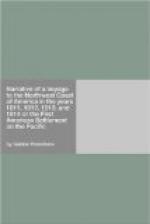On the 30th, while we were yet encamped at Kettle falls, Messrs. J. Stuart and Clarke arrived from the post at Spokan. The last was mounted on the finest-proportioned gray charger, full seventeen hands high, that I had seen in these parts: Mr. Stuart had got a fall from his, in trying to urge him, and had hurt himself severely. These gentlemen not having brought us the provisions we expected, because the hunters who had been sent for that purpose among the Flatheads, had not been able to procure any, it was resolved to divide our party, and that Messrs. M’Donald, J. Stuart, and M’Kenzie should go forward to the post situated east of the mountains, in order to send us thence horses and supplies. These gentlemen quitted us on the 1st of May. After their departure we killed two horses and dried the meat; which occupied us the rest of that day and all the next. In the evening of the 2d, Mr. A. Stuart arrived at our camp. He had recovered from his wounds (received in the conflict with the natives, before related), and was on his way to his old wintering place on Slave lake, to fetch his family to the Columbia.
We resumed our route on the morning of the 3d of May, and went to encamp that evening at the upper-end of a rapid, where we began to descry mountains covered with forests, and where the banks of the river themselves were low and thinly timbered.
On the 4th, after having passed several considerable rapids, we reached the confluence of Flathead river. This stream comes from the S.E., and falls into the Columbia in the form of a cascade: it may be one hundred and fifty yards wide at its junction.
On the morning of the 5th, we arrived at the confluence of the Coutonais river. This stream also flows from the south, and has nearly the same width as the Flathead. Shortly after passing it, we entered a lake or enlargement of the river, which we crossed to encamp at its upper extremity. This lake may be thirty or forty miles, and about four wide at its broadest part: it is surrounded by lofty hills, which for the most part have their base at the water’s edge, and rise by gradual and finely-wooded terraces, offering a sufficiently pretty view.
On the 6th, after we had run through a narrow strait or channel some fifteen miles long, we entered another lake, of less extent than the former but equally picturesque. When we were nearly in the middle of it, an accident occurred which, if not very disastrous, was sufficiently singular. One of the men, who had been on the sick-list for several days, requested to be landed for an instant. Not being more than a mile from the shore, we acceded to his request, and made accordingly for a projecting head-land; but when we were about three hundred or four hundred yards from the point, the canoe struck with force against the trunk of a tree which was planted in the bottom of the lake, and the extremity of which barely reached the surface




